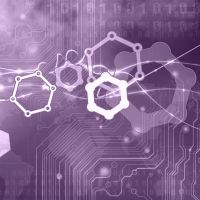Offre de thèse
LUE - Interactions protéine-membrane et protéine-protéine décrites avec des objets mous
Date limite de candidature
31-05-2025
Date de début de contrat
01-10-2025
Directeur de thèse
MALLIAVIN Thérèse
Encadrement
Protein-membrane and protein-protein interactions described with soft objects
Type de contrat
école doctorale
équipe
contexte
La modélisation à gros grains se développe depuis une bonne dizaine d'année pour pouvoir prendre en compte les systèmes de plus en plus gros étudiés en biologie structurale. Les modèles à gros grains les plus répandus, comme celui de Martini, adoptent une approche ascendante dans laquelle la description atomique complète des résidus d'acides aminés est remplacée par une description avec un nombre réduit de billes. Chacune de ces billes est déterminée par la fusion de quelques atomes. Ici, nous proposons d'explorer un nouveau point de vue sur la modélisation à gros grains.spécialité
Chimielaboratoire
LPCT - Laboratoire de Physique et Chimie Théoriques
Mots clés
biophysique computationelle, matière molle, interaction protein-membrane, tensegrité
Détail de l'offre
Le projet de thèse vise à développer un modèle de matière molle décrivant l'interaction entre protéines et membranes. Les modèles à gros grains les plus répandus, comme celui de Martini, adoptent une approche ascendante: la description atomique complète des résidus d'acides aminés est remplacée par une description avec un nombre réduit de billes. Chacune de ces billes est déterminée par la fusion de quelques atomes. Nous proposons d'explorer une approche descendante, en considérant les structures de protéines ou de régions protéiques comme des objets mous dont la forme est proche de celle de la surface moléculaire considérée. La forme de la surface sera maintenue grâce à un schéma de tenségrité, déjà testé sur des éléments de structure secondaire simples. La modélisation des interactions de ces objets mous avec la membrane permettra d'explorer de grandes transitions structurales grâce au nombre réduit de degrés de liberté.
Keywords
computational biophysics, soft matter, protein-membrane interaction, tensegrity
Subject details
The PhD project intends to develop a soft-matter model describing the interaction between proteins and membranes. Most widely used coarse-grained models, like Martini, take a bottom-up point of view in which the full-atom description of amino-acid residues is replaced by a description with a smaller number of beads. Each of these beads is determined by merging a few atoms. We propose to explore a top-down point of view in which we aim at handling the proteins or protein regions as soft objects whose shape is close to the shape of the molecular surface of the considered protein. The surface shape will be maintained using a tensegrity scheme that has already been tested on simple secondary structure elements. The modeling of the interactions of such soft objects with the membrane will permit to explore large structural transitions thanks to the smaller number of degrees of freedom.
Profil du candidat
Nous recherchons un doctorant hautement qualifié, doté d'un excellent dossier académique, notamment d'excellentes notes au niveau master, conformément aux normes rigoureuses de notre école doctorale. Les candidats retenus doivent être titulaires d'un master en physique ou en chimie et posséder des connaissances en physique de la matière molle et/ou en simulations de dynamique moléculaire. Une connaissance de la programmation informatique (Python) est essentielle. Une bonne maîtrise de l'anglais, à l'écrit comme à l'oral, est obligatoire.
Candidate profile
We are seeking a highly qualified PhD candidate with an excellent academic record, particularly demonstrated by outstanding grades at the Master's level, in alignment with the rigorous standards of our PhD school. Successful candidates must hold a Master's in physics or chemistry and possess knowledge of soft matter physics and/or molecular dynamics simulations. Familiarity with computing programming (python) is essential. Good knowledge of English, both written and oral, is compulsory.
Référence biblio
1. Carlier L, Samson D, Khemtemourian L, Joliot A, Fuchs P and Lequin O. Anionic lipids induce a fold-unfold transition in the membrane-translocating Engrailed homeodomain. Biochim Biophys Acta Biomembr 1864, 184030 (2022)
2. Chen EH, Wang CH, Liao YT, Chan FY, Kanaoka Y, Uchihashi T, Kato K, Lai L, Chang YW, Ho MC and Chen RP. Visualizing the membrane disruption action of antimicrobial peptides by cryo-electron tomography. Nat Commun14:5464 (2023)
3. Delort A, Cottone G, Malliavin TE and Müller MM. Conformational Space of the Translocation Domain of Botulinum Toxin: Atomistic Modeling and Mesoscopic Description of the Coiled-Coil Helix Bundle. Int J Mol Sci 25, 2481 (2024)
Fierling J, Johner A, Kulić I, Mohrbach, H and Müller MM. How bio-filaments twist membranes. Soft Matter 12, 5747 (2016)
4. Grage S, Afonin S, Kara S, Buth G and Ulrich A. Membrane Thinning and Thickening Induced by Membrane-Active Amphipathic Peptides. Front Cell Dev Biol 4, 65 (2016).
5. Klein J, Schad L, Malliavin TE, Müller MM. Protein-membrane interactions with a twist. In revision.
6. Turbant F, Waeytens J, Campidelli C, Bombled M, Martinez D, Grélard A, Habenstein B, Raussens V, Velez M, Wien F, Arluison V. Unraveling Membrane Perturbations Caused by the Bacterial Riboregulator Hfq. Int J Mol Sci 3:8739 (2022)



